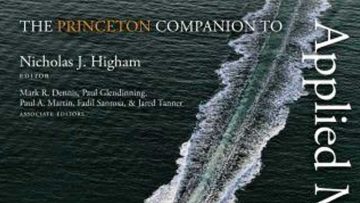The 2020 IMA Gold Medal was awarded to Nick Higham. This article is based on the Gold Medallist Talk that he gave at the Mathematics 2021 conference on 6 May.

For most researchers a project begins with an idea and finishes, months or years later, with a published paper and a conference talk or two. The research is thereby disseminated to experts, but others may not see it or may not appreciate how it could be useful to them. I would like to argue that, at least for some types of research, it is worth disseminating the work in other forms that are more accessible to potential beneficiaries further afield.
One vehicle for wider dissemination is, of course, magazines of scholarly societies and professional bodies, such as Mathematics Today, the LMS Newsletter, SIAM News, Significance, and The Actuary. Another is blogs. A blog is a website displaying a list of dated articles (posts), usually in reverse chronological order.
During my time as president of SIAM (2017–2018), I wrote a column in SIAM News. Of the twenty columns, which were on a variety of topics, the ones that generated the most feedback touched on research. For example, a column [1] discussed the complex step approximation
which has the important property that one can take a very small step without rounding errors vitiating the approximation. My own interest in this approximation stems from the fact that it can be generalised to approximate the Fréchet derivative of a matrix function in a given direction [2]. The complex step approximation was proposed in 1998 by Squire and Trapp [3], and while that paper has been well cited, the approximation is not well known – in particular, few textbooks mention it. I received feedback on this column from people who were happy to learn about the approximation and to use it in their applications. For example, one reader used it in plotting the Sarti dodecic surface.
Articles in magazines are a great way to promote research results more widely, but there is a limited number of article slots, as well as a delay between submission and publication. An alternative is to publish an article as a blog post, on one’s own blog or a blog belonging to an organisation. There are many examples of the latter. The Bank of England has a very active and professionally produced blog, Bank Underground, to which I have contributed an article about research on correlation matrices [4]. The LSE Department of Mathematics has a research blog. SIAM has a blog that lives alongside the content of SIAM News and covers research, conferences, science policy, and so on. The numerical linear algebra group in Manchester has a blog, as does the mathematics of waves and materials group.
I recently worked on accurately computing the log-sum-exp function
where log is the natural logarithm. In machine learning and statistics, a standard way to avoid overflow in the evaluation is to rewrite
In writing the paper [5], my co-authors and I wanted to cite a reference for this ‘log-sum-exp trick’. We could not find a canonical reference in the research literature, but we found many blog posts (and even a YouTube video) that explain the technique, and I suspect that most users learn the trick from these sources.
The technical barrier to setting up your own blog is essentially zero. For example, anyone can sign up for a free WordPress blog. Posts can be entered using a wysiwyg editor and mathematical equations can be entered in form using the syntax
(If your WordPress installation allows plugins, you can install a MathJax plugin and then type
equations in the usual way). WordPress offers many professionally written styles (called themes) so your blog will look attractive.
The hardest part of running a blog is writing the content. In my experience, if a piece of research is close to complete and fresh in your mind it can be easy to write a compelling blog post, which could be an expansion of the elevator pitch that you would use to describe the work to a colleague, a potential research student, or a funder. Blog posts can contain graphics, links to videos, and links to other webpages and papers.
Blogs have several advantages over conventional publications.
Instant publication
On your own blog you can publish a post as soon as it is ready. On an institutional blog there may be a short delay, but it will be far less than the time to publication for a conventional outlet.
Rapid feedback
Blogs allow a reader to type a comment in a box at the end of a post, to which the author can reply (comments have to be approved by the blog owner, so inappropriate ones can be filtered). Comments can include information, corrections, and links, which can generate fruitful discussion.
Easy updating
A blog post can easily be updated at any time. If a reader reports a typo on one of my posts I can quickly make an edit to correct it.
Freedom from conventions
On a personal blog one is not bound by the usual conventions, so one can use informal language, unusual layouts, whimsical content, or present incomplete ideas.
Usage statistics
Blogs provide the site owner with statistics on the number of views for each post over different periods, which countries the views are coming from, what sites referred readers to the blog, which files were downloaded, and which links were clicked. By contrast, for journal articles one usually has only citations as a measure of the audience reached.
I often do a Google or DuckDuckGo search on a technical term in order to find out what it means (most recently, for example, to check the definition of ‘polytope’). Usually I end up on a Wikipedia page. Wikipedia is a valuable resource for mathematics, but not every topic is covered and sometimes the pages are rather verbose. Early in 2020 I decided to start a ‘What Is’ series of posts on my blog. The aim was to provide brief descriptions of important concepts in numerical analysis and related areas, with a focus on topics arising from my research. The articles were meant to be short, widely accessible, and contain a minimum of mathematical symbols, equations, and citations. I decided to make the articles available in PDF form on GitHub, as well as on the blog. By April 2021, I had written 50 articles on topics ranging from the basic ‘What Is a Matrix?’ to the more advanced ‘What Is the CS Decomposition?’. The series has struck a chord and the posts have received from hundreds to thousands of views, with some very useful feedback in the comments. To my surprise, a search for the blog titles (or the titles minus ‘what is’) usually has my post on the first page of results and sometimes ahead of a corresponding Wikipedia page.
Two reasons for not writing blog posts are that you want to write in regular and not in the syntax of the blog platform, so that your text can be used as-is in other places (course notes, research papers, books), and that you fear your blog posts will never be read.
In answer to the first concern, it is possible to write in a markup language that can include regular and export from it to WordPress and other formats; this is my approach [6] (I use Emacs Org mode). It is also possible to write posts in a notebook document such as a Jupyter notebook or the MATLAB Live Editor, export to html, and include the html in the blog (various blog posts are available on how to do this).
Regarding visibility, blogs have a big advantage over PDF papers in that with a suitable platform (including WordPress with a modern theme) the blog is responsive, meaning that the pages resize and the font adjusts for the device on which it is being viewed. Google is known to give a ranking boost for mobile-friendly websites, and I have noticed that if I do a regular Google search for a topic on which I have written both a blog post and a paper, the blog post tends to appear before the paper in the search results (note that Google Scholar does not index blog posts). A good way to promote blog posts is via Twitter, where retweets by accounts with many followers can greatly expand the readership.
The traditional journal paper and conference talk are as relevant as ever, but articles and blog posts provide other ways to promote our (and other people’s) work to a wider audience. I encourage you to give them a try.
Nicholas J. Higham FRS CMath FIMA
University of Manchester
References
- Higham, N.J. (2018) Differentiation with(out) a difference, SIAM News, vol. 51, no. 5, p. 2.
- Al-Mohy, A.H. and Higham, N.J. (2010) The complex step approximation to the Fréchet derivative of a matrix function, Numer. Algorithms, vol. 53, no. 1, pp. 133–148.
- Squire, W. and Trapp, G. (1998) Using complex variables to estimate derivatives of real functions, SIAM Rev., vol. 40, no. 1, pp. 110–112.
- Georgescu, D. and Higham, N.J. (2018) Completing Correlation Matrices, Bank Underground blog.
- Blanchard, P., Higham, D.J. and Higham, N.J. (2020) Accurately computing log-sum-exp and softmax functions, IMA J. Numer. Anal.
- Higham, N.J. (2021) My Blog Workflow.
Reproduced from Mathematics Today, August 2021
Download the article, Disseminating Research Through Articles and Blogs (pdf)



